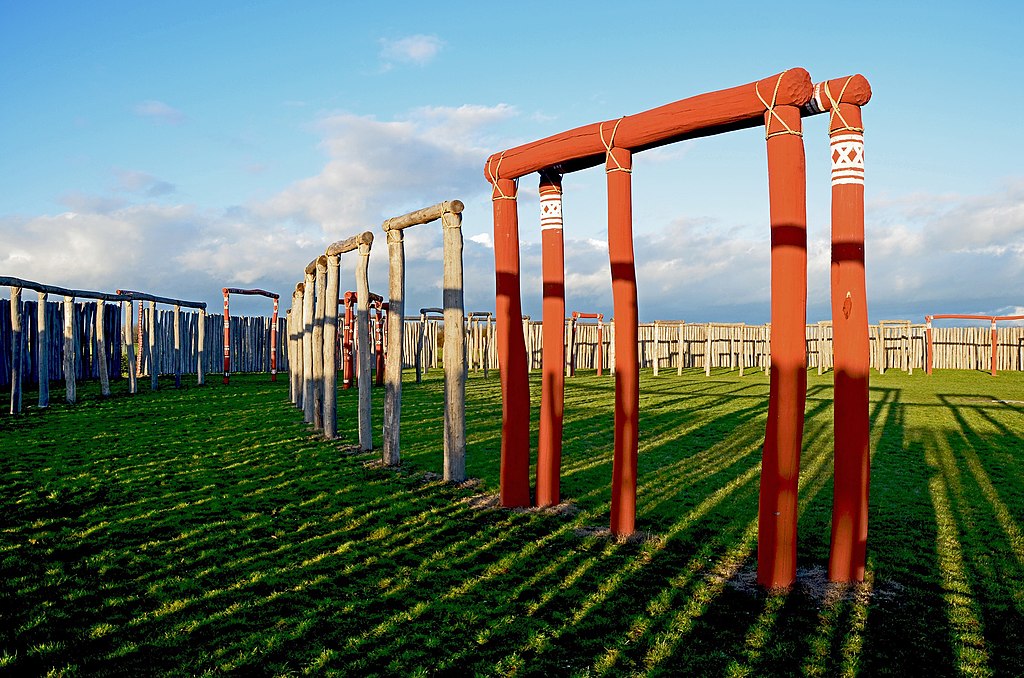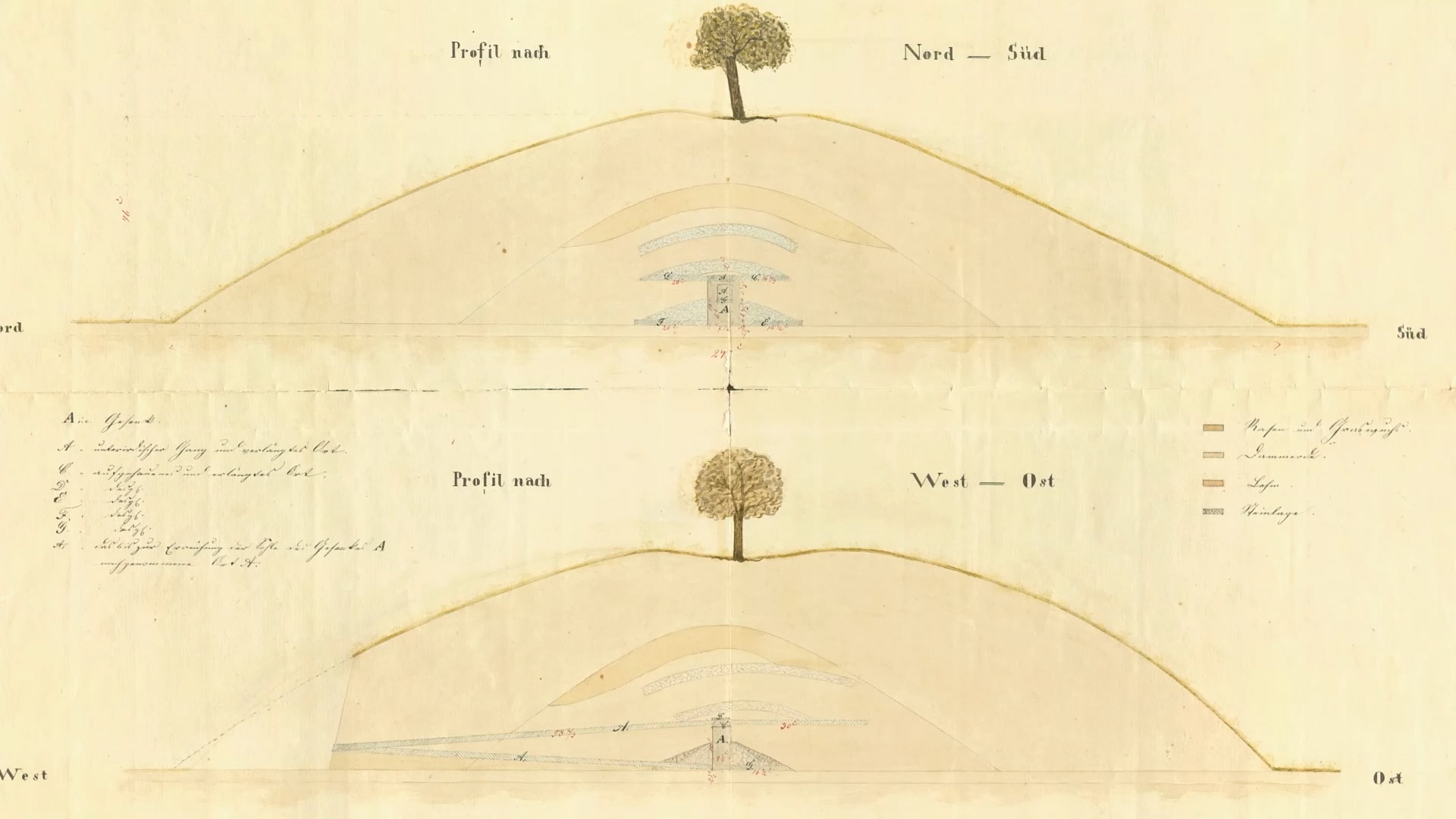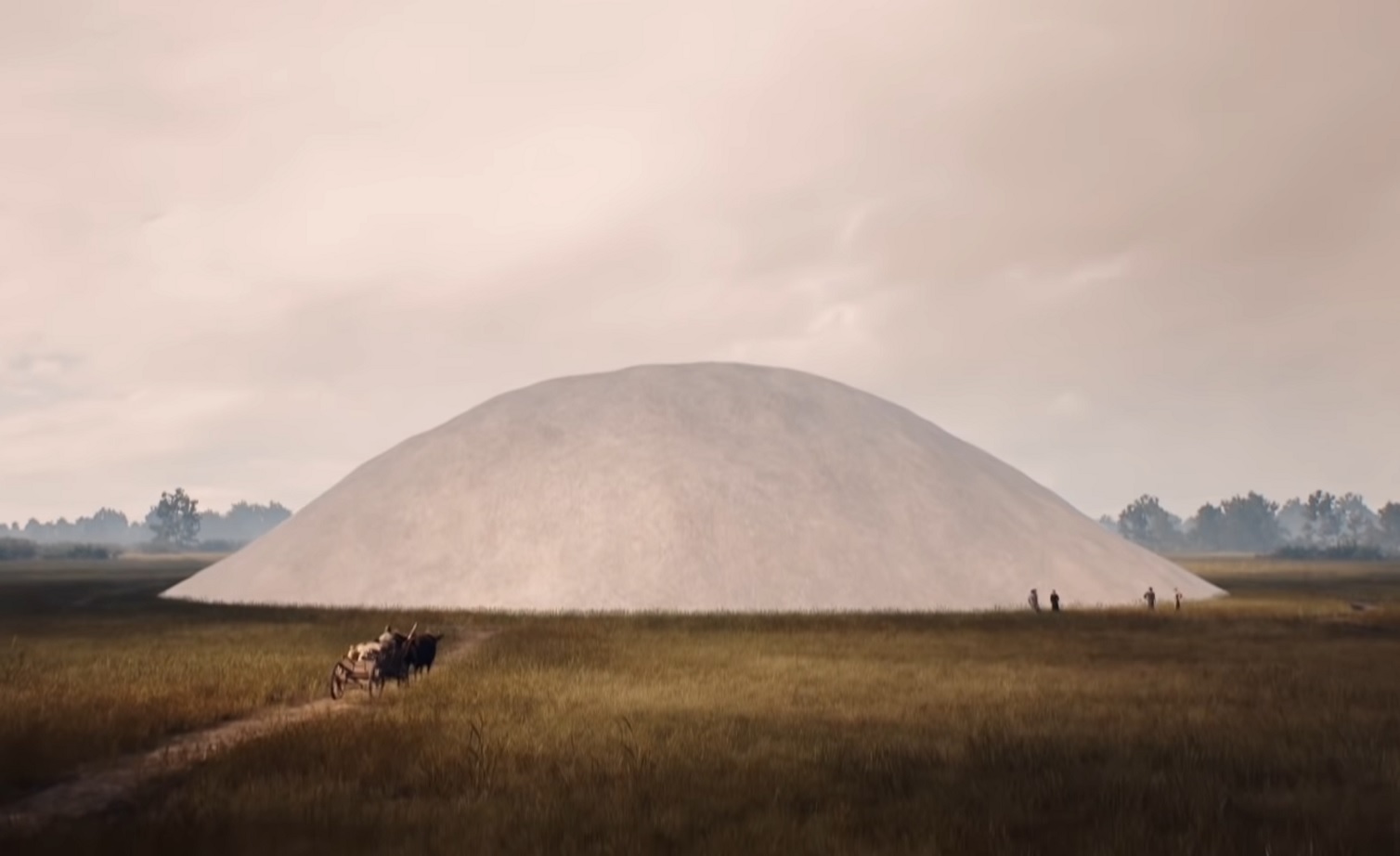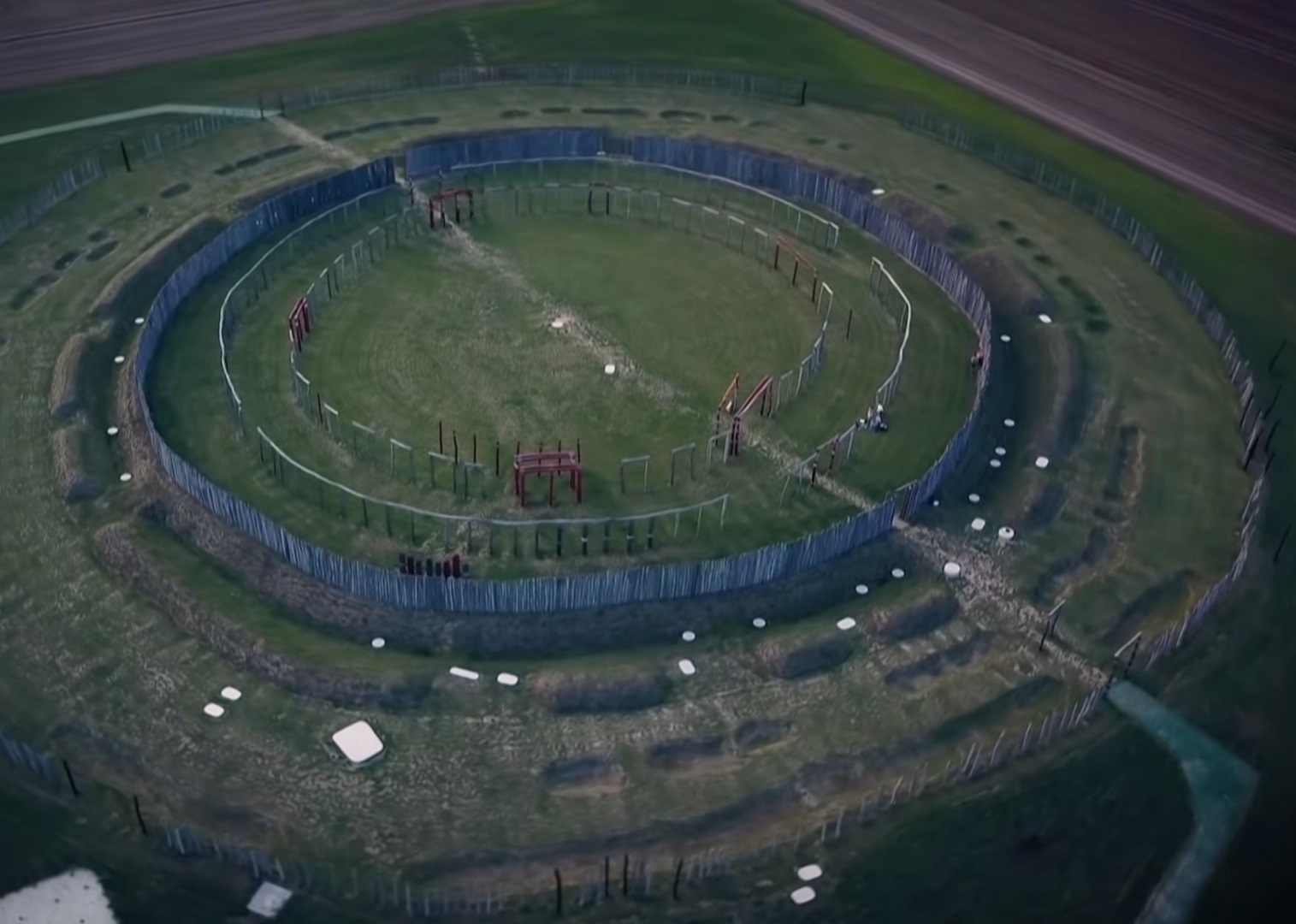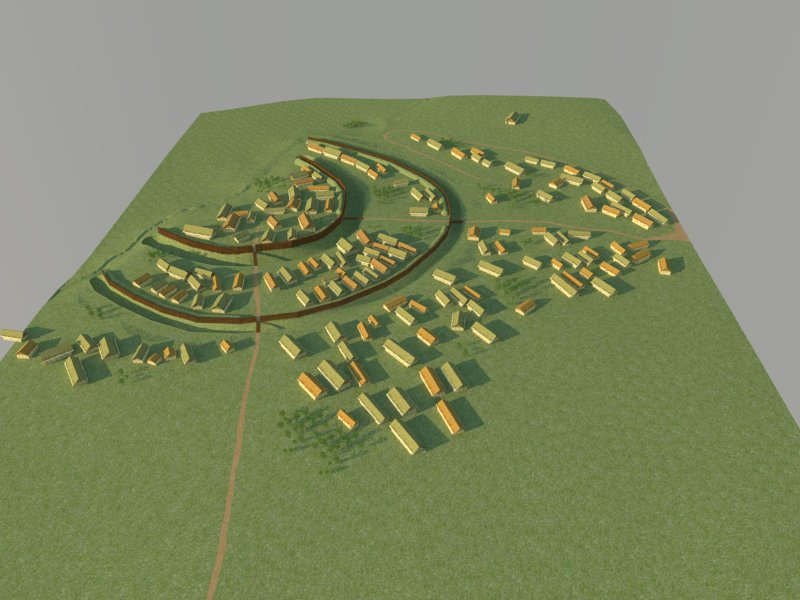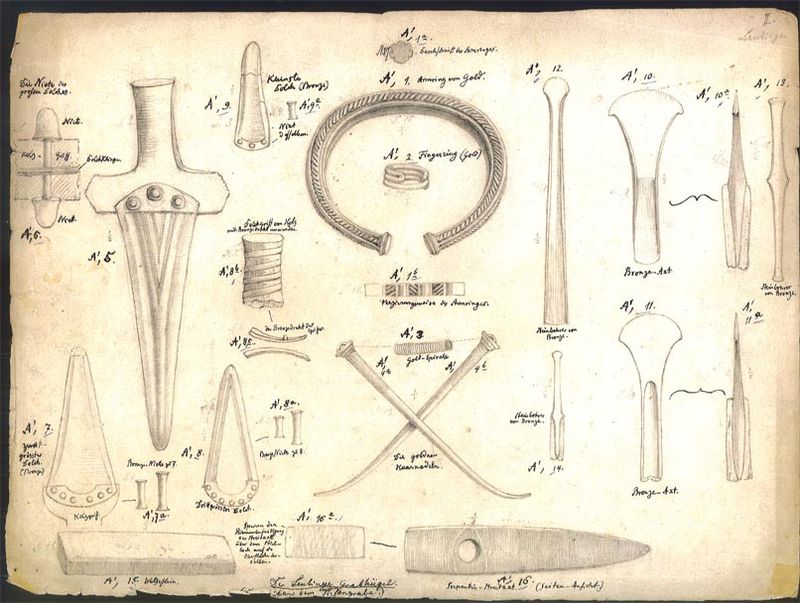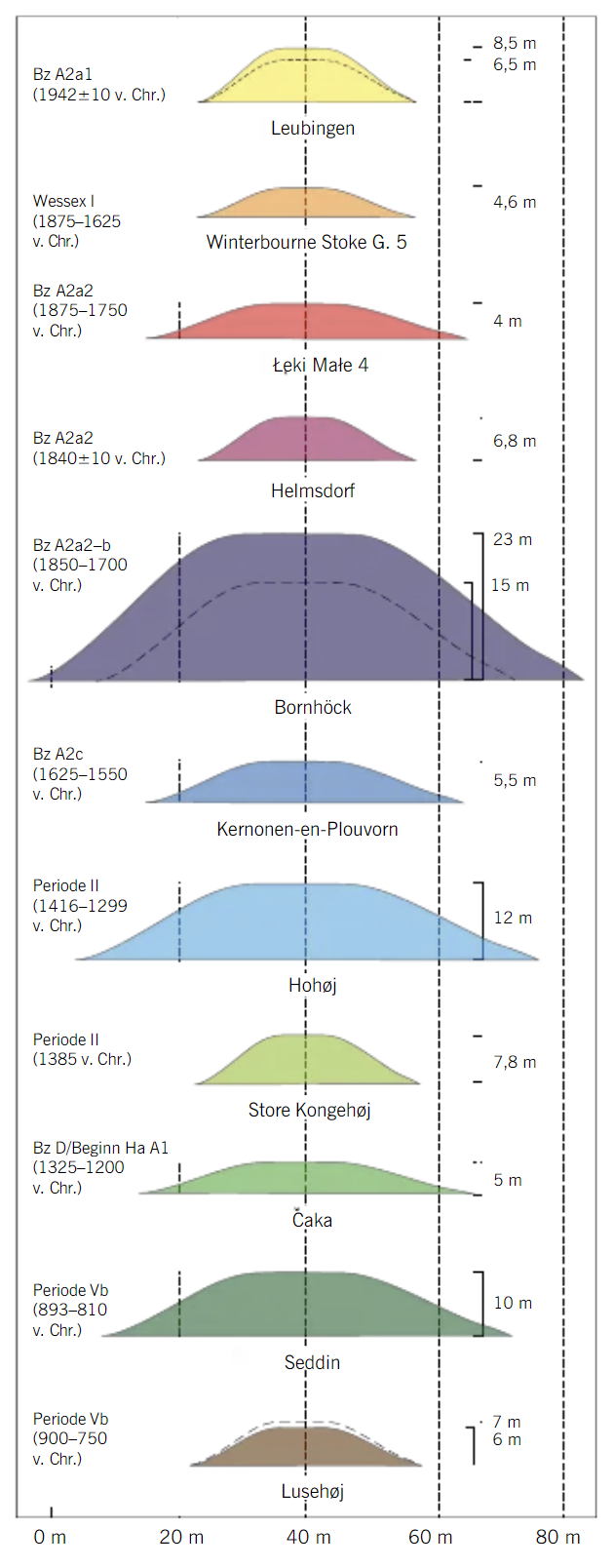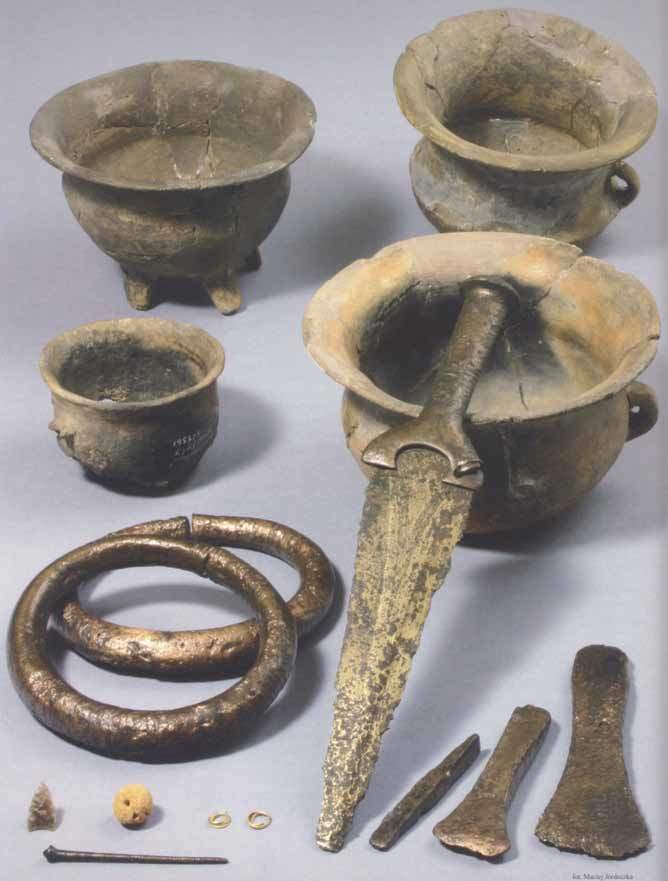Unetice Culture
This culture existed from 2300 BC to 1600 BC in the territory of what is now Western Poland, Eastern Germany, Czech Republic, Western Slovakia and Northern Austria. There are about 1400 documented Unetice Culture sites in the Czech Republic and Slovakia, 550 sites in Poland and Germany and about 500 sites and loose finds in remaining locations. Its Eastern neighbors were the Mierzanowice Culture[1] and early Bronze Age Balts[2]. Its Northern neighbor was the early Nordic Bronze Age and Bell Beaker Culture in Netherlands, and its Southern neighbors were the Straubing and Ottomány cultures. The people who made up this culture were the descendants of the Corded Ware, Globular Amphora and Bell Beaker cultures.
This culture became evident in modern archaeology when in 1879 AD Czech surgeon and archaeologist Čeněk Rýzner discovered a burial ground of over 50 people on a hill overlooking the Bohemian village Únětice.
There was a trade route through which amber was moved from the Baltic coast of Poland through what is now Czech Republic territory to the South of Europe. Baltic amber has been found in Mycenaean graves and in the wider Aegean. Czech discoveries from the time of the Únětice Culture feature many amber artefacts and in a greater density than in nearby Germany. Around 2100 BC copper deposits began to be transported to Denmark and Southern Sweden from Western Slovakia, Austrian Inn Valley and British Isles (Armorica British Bronze Age), the tin deposits came from Cornwall and Eastern Germany[3].
The Unetice Culture related Brotlaibidole (loaf of bread idols; la tavoletta enigmatica) might be the earliest version of the counting system in Europe[4]. Those mysterious tablets also appeared in the Polada Culture (2200 BC - 1600 BC) of Northern Italy[5].
Settlements
In the Early Bronze Age at least one thousand people lived in a fortified settlement at the location of Vráble-Fidvár (near Žitavská, Slovakia), this represents an exceptionally large population for that period. Other such settlements known to date housed three hundred people at most.
The important archaeological site at Vráble-Fidvár, which is located on the left bank of the Žitava River, had already been settled in the later Stone Age (4000 BC to 3000 BC). In the Early Bronze Age (2100 BC to 1450 BC) the settlement was gradually encircled by three trenches. In the fortification there were more than 160 floorplans of dwellings which were arranged in a radial manner in a number of rows along the circular fortification. Using the C14 radiocarbon method, they were dated to the period of 2100 BC to 1800 BC[6]. Research led by professor Jozef Bátora from Comenius University revealed that in the Central European context the site's proto-urban architecture and buildings are at least three hundred years older than examples known to date from previous archaeological findings.
There were 5 skeletons found in a burial pit in Cezavy, Blucina in Czech Republic[7]. In Blučina itself there are remains of a Unetice hillfort from around 1900 BC[8]. The Bruszczewo settlement in Poland was inhabited from as early as 2100 BC until 800 BC.
A fort on the confluence of the Lužnice and Vltava rivers was a major trading settlement, ceramic objects that come from the Danube basin were found there. The most effective form of transportation at that time in Southern Bohemia was using waterways. This fort surveyed the amber route. It was also found that the rear palisade of the fort also served as the rear wall for the buildings there. These forts were small so not many people lived there[9].
During the Bronze Age around 2000 BC Pömmelte in Germany was the site of an astronomical observatory with a function similar to Stonehenge, built in a wooden construction. It probably was a ritual center, without a permanent settlement. With radiocarbon dates indicating 2300 BC for what appears to be the earliest phase of the ritual center[10][11]. Other similar structures are for example 5000 BC Goseck circle (Germany), 4500 BC Pietrowice Wielkie circle (Poland) and later Dacian Sarmizegetusa circle (Romania). The Pommelte circle was reconstruted in the years 2014 - 2022, 24 years since its first discovery in 1990[12].
The hoard of Dieskau II with 14 staff daggers or their blades obviously represents high-ranking warriors. This is also supported by the imported Anglo-Irish marginal axe, which, like axes found in rich graves, consists of tin bronze that once gleamed with gold - in contrast to the copper axes found in large hoards. You can see how it looked like by clicking here.
Single artifact finds (hoards) were found in: Szczecin, Słupy (near Bydgoszcz), Bresinchen (in Landkreis Spree-Neiße, bronze halberds and ornaments), Dieskau II (14 bronze halberds similar to those potrayed on Italian Polada Culture petroglyphs)[13], Dieskau III (over 30 axe heads)[14], Nowa Wieś Lęborska (halberd blade)[15], Stargard[16], Mierzeszyn (near Gdańsk), Marcinowice[17], Neunheilingen, Melz (8 halberds), Markosice (2 halberds), Trieplatz (1 halberd and 1 simple bronze helmet).
People from the Unetice Culture used the following spices and herbs in the Early Bronze Age: Fennel (Foeniculum vulgare), White goosefoot (Chenopodium album), Mint (Mentha aquatica and Mentha spicata), Cranberries (Oxycoccus), Elderberries (Sambucus nigra), Raspberries (Rubus), Thyme (Thymus vulgaris), Sage (Salvia pratensis), Poppy (Papaver somniferum), Mustard seeds (Sinapis/Brassica), Horseradish (Armoracia rusticana), Garlic (Alliaria petiolata)[18]. Meat from cattle[19], drop bustard (otis tarda)[20], sheep, pig, horse, wolf (canis lupus, in Pasohlávky[21]), red deer[22] was also consumed.
Bruszczewo and Metallurgy
Among the finds in Bruszczewo were a stone casting mould, jets, crucibles, hatchets, a dagger, and clay pads on which hot objects were placed. One site is interpreted as the workshop of an early Bronze Age metallurgist. It is a unique find in Europe. Thanks to the use of a metal detector in the new survey, further 50 bronze objects were found, both heavily worn (daggers) and barely out of the mould, on which the casting seams were still visible (round beads).
The expedition currently at work has made an interesting discovery about the use of metal tools. It turned out that the entire wooden fortifications and house structures were made with bronze tools, not flint. Elements of the settlement are currently buried in peat bog. As a result, their state of preservation is sensational. Peats preserve all kinds of organic materials perfectly.
In recent seasons, the gate foundation was investigated and located through geophysical prospecting. The degree of destruction of the gate was quite high. The remains of a pillar-like building with braided walls, which was located opposite the entrance, were preserved. The double oak palisade surrounding the settlement had a break at this point. The entrance to the settlement was located where the moat narrowed and was divided by a ramp, instead of the bridge expected by archaeologists. The builders took advantage of the natural terrain to locate the entrance in this way. Another interesting find of the last survey season was also the remains of a Bronze Age bridge in the South-Western part of the site. It is likely that this site was used to draw water from the lake or as a boat landing[23].
Other finds included smelting by-products (metal prills/droplets) and unfinished and never used artefacts with preserved casting seams. The artefact assemblage recorded at Bruszczewo connected with metallurgy but made of other materials is unique in Europe: tuyeres, melting pots, clay footings, as well as a stone casting mould used for making open bracelets[24].
Burials
2200 burials from 2300 BC to 1600 BC were found in Franzhausen, Austria. The dead were buried in flexed, gender-specific body position, usually in individual graves. Women were placed on the right side of the body, head South, whereas men were placed on the left, head North. Grave goods comprise bronze costume and jewellery, weapons and tools, ceramic vessels as well as meat produce[25].
Single graves of the Unetice Culture were found in: Przecławice (with Uneticean mugs), Modřice, Velké Pavlovice (22 graves[26]), Kleinpaschleben (2132 BC - 1940 BC, with a longhouse[27][28]), Koperniki (near Nysa)[29], Szczecin-Płonia (11 graves)[30], Holubice (in the Praha-západ district)[31], (Jedrychowice, Nowa Cerkiew, Widawa, Niedary, Piskorzowek, Nowa Wieś Bolesławiecka)[32], Šoporňa (near Galanta), Jevišovka-Nová[33].
Kurgan graves (barrows) in: Szczepankowice (1600 BC)[34], Wojkowice, Kąty Wrocławskie (1950 BC - 1759 BC)[35], Brandýs nad Labem (near Prague), Łęki Małe, Jelšovce (near Nitra), Bruszczewo[36], Lovosice (2021 BC - 1751 BC, near Litoměřice[37])[38], Velké Žernoseky (barrows covered the Funnelbeaker Culture graves)[39].
The anti-barrow (Jelšovce 527) contained the housing structure (the house of the dead), but was lacking the soil cover of the tomb (the mantel). The grave 527 from Jelšovce cemetery was located outside of the main burial ground, in a distance of 200 m. The tomb was a free standing wooden house, inside of which the burial chamber was dug into the ground. In the middle of the house a large hearth contained burnt personal belongings of the deceased (family group of 5 individuals). The radiocarbon dating revealed that the tomb was in use in the classic period around 1500 BC for at least 200 years. The bodies of the deceased were added gradually over longer period of time[40].
Bronze Age Cemetery in Leki Male
In 1881 AD there were still 11 kurgans present in the Łęki Małe cemetery. It is suspected that the total amount of kurgans there still present during the Bronze Age was 14. To this day only 5 kurgans survived the 19th and 20th centuries.
Kurgan I - This kurgan dates to circa 2040 BC - 1883 BC (radiocarbon dates of wooden chamber A). It contained the burials marked as A (in the center) B, C, D, E, F. All those burials were created around the same time. The main burial A contained skeletons of a man and a woman, bronze halberd (with a wooden core inside), bronze dagger, 2 bronze armbands, gold ring, pottery in a wooden chamber. Above this burial were 7 skeletons of horses, 7 skeletons of cattle and 3 skeletons of sheep. The burial D contained 2 pieces of amber, bronze pins and a bronze dagger, which was repaired shortly before the burial.
Kurgan II - It contained remains of a young male and possible 3 other humans[41]. Inside there were 11 pieces of flint tools, 3 ceramic vessels, 42 potsherds and animal bones.
Kurgan III - It contained only two burials A and B. The burial A had the most skeletons in it, distributed on 18 levels in a 4.6 meters deep chamber. One discovered male skeleton had a height of 172 cm, another one was determined to be 24 years old, third male skeleton was also around the same age. Other pieces of human bones did not survive as whole skeletons. The equipment of the grave B consisted of 2 vessels (from middle phase of the Unetice Culture circa 1900 BC), 2 bronze pins and 2 golden spirals. Other artifacts found in this kurgan consisted of ceramic vessels, many potsherds, flint tools, amber bead and charcoal. The bones left after funeral feast were those of horses, cattle, swine, sheep and deer.
Kurgan IV - This is the oldest kurgan from the cemetery dating to the times of the Corded Ware Culture. The burial A contained skeletons of 50 years old male, 10 years old boy, 14 years old girl and 30-40 years old male. The artifacts found in this kurgan consisted of ceramic vessels, over 200 potsherds, bronze sheet, flint tools, ochre and charcoal. There were found many bones of young horses, cattle, swine, sheep and goats above the burial chambers, probably from the funeral feast. One skeleton from this barrow marked RISE431 was determined to belong to Y-DNA haplogroup R1a-M417 (R1a1a1), mtDNA T2a and dated to 2286 BC - 2040 BC[41]. The amount of T2 haplogroup is around 7% in modern day population of Poland.
Kurgan V - Farmers reported finding pieces of pottery and large stones around this kurgan.
Kurgan VI - In the 19th century a bronze dagger was found in this kurgan. Later excavations led to the discovery of one bronze pin, 15 flint tools, animal bones, charcoal and bones.
Kurgan VII - A full skeleton was found in it just before the construction of the rail road in 19th century.
Kurgan VIII - Bone fragments and two vessels were found in this kurgan.
Nebra Sky Disc

In 1999, the discovery of the so-called Nebra Sky Disc by a German metal detectorist led to further astounding finds. The gold that is featured on the disc came from as far away as Cornwall in Britain[42].
The Nebra Sky Disc depicts the same astronomical phenomenon as described on some Mesopotamian tablets. If the four-day-old crescent moon appears next to the constellation of the Pleiades then an intercalary month is necessary to ensure the calendar remains accurate. The Nebra Sky Disc shows that the astronomical knowledge originally developed in Mesopotamia and Egypt was also present in Central Europe. The presence of a lunisolar calendar in Central Europe's Early Bronze Age shows how Bronze Age societies in Central Europe were far more developed than previously thought.
The Nebra hoard contained the Sky Disc, two swords (or medium daggers), two axes, one chisel and two arm spirals. Since the Nebra Sky Disc is a unique find that was not recovered during a controlled excavation, it can neither be dated by traditional typological methods nor prima facie by its appearance. Moreover, there is no scientific method yet available to date copper alloys exactly, so that the date suggested in the original publication was established by reconstructing the find context and by analysing the accompanying finds that are typologically and radiocarbon dated to around 1600 BC. The find location on the Mittelberg was excavated in great detail and a number of scientific analyses confirmed the testimony of the looters in a court trial that the Sky Disc had been buried there together with the accompanying finds. These analyses also disproved an earlier claim that the Sky Disc was a modern fake[43].
Origins of Latin
A study from 2021 confirms the diversity of ancestry components during the Copper Age (3600 BC - 2200 BC) and the arrival of the Steppe (Yamna) related ancestry in the Central Italy as early as 1600 BC[44].
An individual from Boiron, Italy (BRC003) from around 1532 BC already carried the R1b-P312 Y-DNA haplogroup (from R1b-L151 and brotherly to R1b-U106 common in Britain, Netherlands and Scandinavia). Other individual from the same site carried the R1b-DF90 haplogroup (descendant of R1b-U152 and then of R1b-L2, common in Italy and France). On the PCA those samples lean towards the samples from Spain, Albania, Lithuania, Norway, Ukraine, Estonia when compared to the Copper Age Italian and Sardinian samples[45]. Notice that the dates of those samples predate the Hallstatt Culture.
The R1b subtype found in the Bronze Age Boiron, Italy is a lineage found in both ancient Sicilian samples and Italian Bell Beakers. Together with the autosomal affinity of North and Central Italian Bronze Age groups with Late Copper Age Germany, the data points to a possibly Northern, Transalpine and potentially Bell Beaker associated source of the Italian Steppe (Yamna) related ancestry.
First emerging in the Early Bronze Age Italian Bell Beaker 2195 BC - 1940 BC (I2478), Italian Remedello 2134 BC - 1773 BC (RISE486), Boiron 1952 BC - 1752 BC (BRC010) and increasing through time in the individuals from Boiron and Regina Margherita 1626 BC - 1497 BC (GCP003).
R1b-U152 would have entered Italy in successive waves from the Northern side of the Alps, starting in 1700 BC with the establishment of the Terramare Culture (1700 BC - 1150 BC) in the Po Valley. From 1200 BC a larger group of Hallstatt-derived tribes founded the Villanova Culture.
On the periphery of the Únětice Culture territory, haplogroup R1b-M269 (R1b1a1a2) is found in Gata/Wieselburg near Vienna, Austria (1765 BC), and haplogroup R1b-L151 (R1b1a1a2a1a) in Untermeitingen, Southern Germany (1605 BC)[Allentoft et al. 2015].
The Bronze tools and weapons of the Italian Polada Culture (2200 BC to 1600 BC) already show similarities with those of the Unetice Culture and other groups in the North of Alps including the Singen and Straubing groups. The common Unetice bronze halberd (in Villafranca type) can also be seen among Valcamonica (Cemmo) petroglyphs[46].
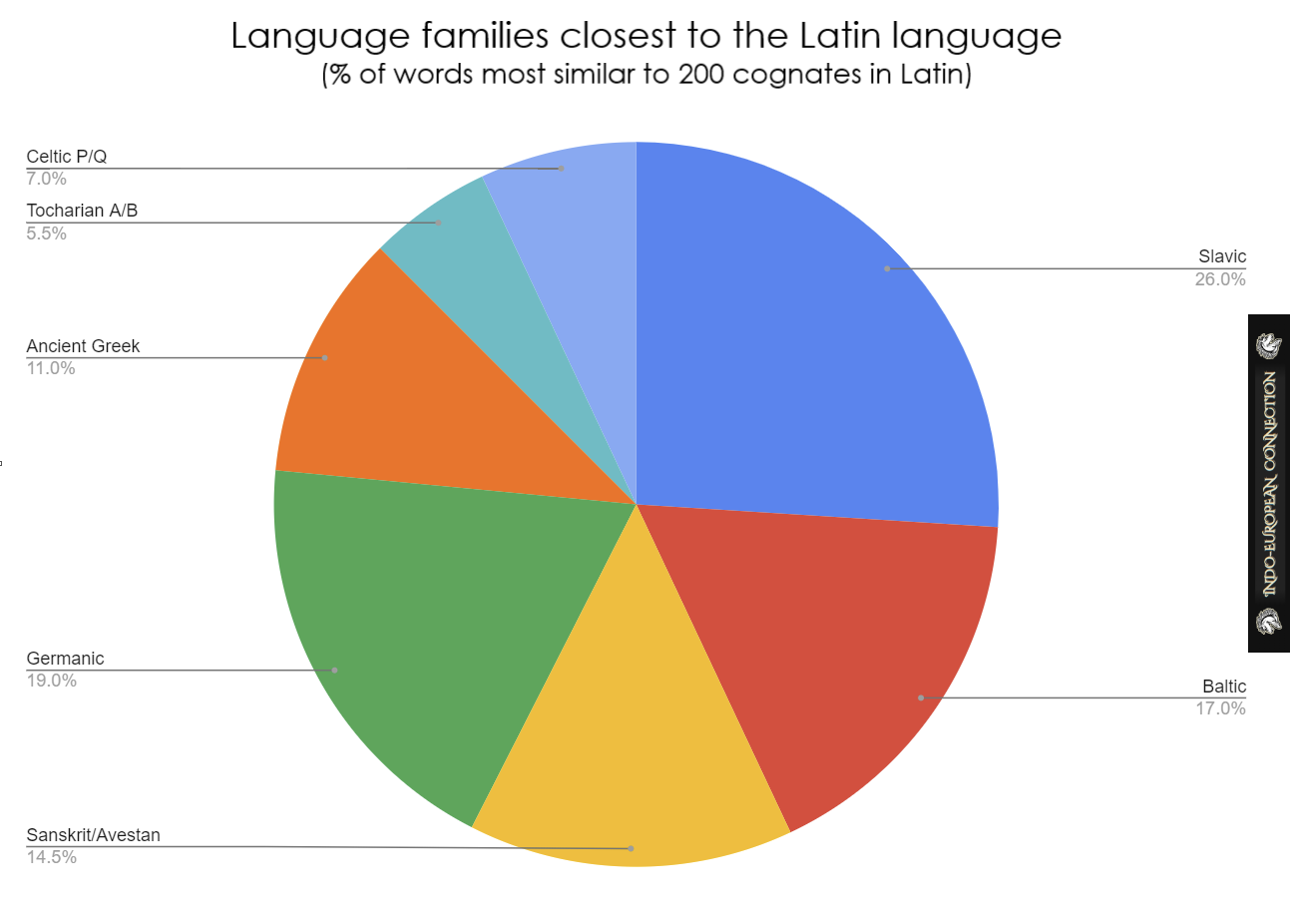
Those dates align perfectly with the Unetice Culture period (also influenced by the ancestral Bell Beakers and CWC) and spread of DOM2 horse after 2200 BC through Central Europe. That is why I decided to create a full list of Latin cognates to determine, which words would show the highest affinity/resemblence to cognates from other Indo-European languages and their families.
The first results when comparing only 40 Latin words were following:
Slavic: 30%; Baltic: 25%; Sanskrit/Avestan: 7.5%; Germanic: 20%; Ancient Greek: 12.5%; Tocharian A/B: 5%; Celtic P/Q: 0%
Taking into account only unique one word to word cognates (meaning only one language could be the source of that cognate):
Slavic: 40%; Baltic: 30%; Sanskrit/Avestan: 10%; Germanic: 10%; Ancient Greek: 10%; Tocharian A/B: 0%; Celtic P/Q: 0%
Then after many hours of work to eliminate any bias and to increase statistical precision the results from 200 compared words were following:
Slavic: 26%; Baltic: 17%; Sanskrit/Avestan: 14.5%; Germanic: 19%; Ancient Greek: 11%; Tocharian A/B: 5.5%; Celtic P/Q: 7%
With one word to word cognate correspondence in only one language family (41 such cognates among those 200 words):
Slavic: 24.4%; Baltic: 17.1%; Sanskrit/Avestan: 17.1%; Germanic: 19.5%; Ancient Greek: 9.8%; Tocharian A/B: 2.4%; Celtic P/Q: 9.8%
Notice the decrease of the Balto-Slavic group, quite stable percentage of Germanic and high increase of the Celtic P/Q. The more compared words the closer to truth the results would be but still it would never reach even 50% similarity to Celtic P/Q languages.
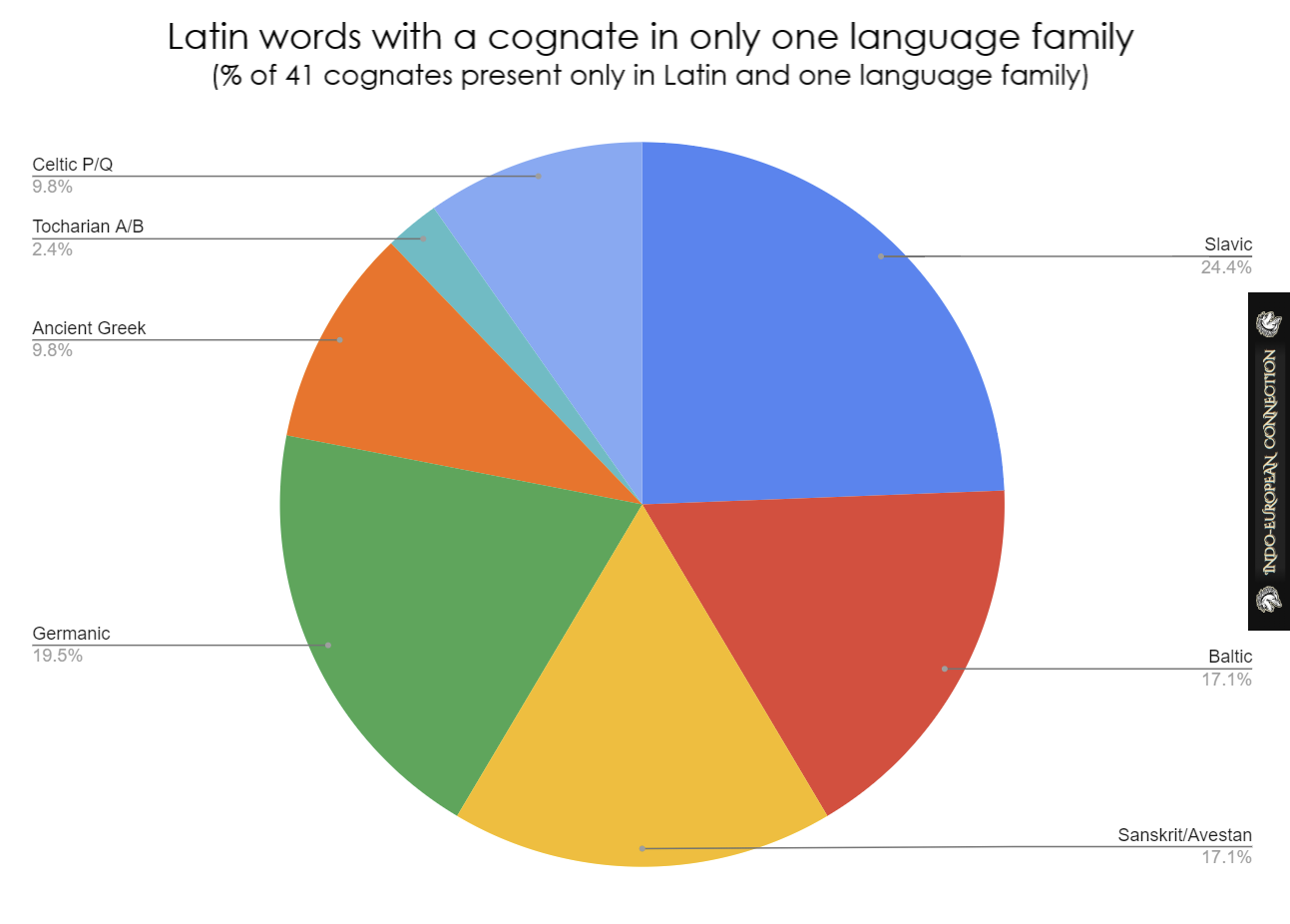
Full data and all compared words can be found IN THIS SPREADSHEET.
Supporting my diagrams above is also a post from the Eurogenes blog, which shows on the PCA that the autosomal genetic samples from the Fatyanovo-Balanovo (Indo-Iranians; Sanskrit/Avestan) and the Unetice Culture (in Slovakia) lay very close to eachother. What is also interesting is that "the peoples associated with the Bronze Age Fatyanovo-Balanovo and Unetice archeological cultures shared strikingly similar metalwork... this similarity is especially pronounced in the metalwork of the Unetice culture from what is now Slovakia"[47]. The Fatyanovo-Balanovo Culture ended around 2050 BC.
This would explain why at its linguistic stage around 2600 BC the language ancestral to Latin would still have those 17% unique cognates related to Sanskrit (not present in Baltic nor Slavic)! For example seen in a Latin word for number nine: "novem", in Welsh "naw" and in Sanskrit "नवन् (navan)" but different "devyni" or "девѧть (devętĭ)" in Balto-Slavic. With an exception in the Old Prussian language "newīnjai" (it also preserved the neutral gender unlike other Baltic languages).
Based on the list of Latin cognates the vocabulary of the Unetice Culture language could be reconstructed as:
- which: kuter / kuetar
Latin "uter" and Oscan "púterelpíd" are strong evidence that the Unetice Culture vocabulary (or earlier Bell Beaker) could also influence the Nordic Bronze Age, later seen in: Gothic "ƕаþаr" and Old Saxon "hwēthar". The evolution of this word went probably from Unetice "*kuter/kuetar" to "*huether/huetar" in Germanic and then "*puther" in Italic. Compare also Sanskrit "कतर (katará)", Czech "který" and Kashubian "chtëren".
- neither: nauter / neauter / neother / nekuter
In Latin "neuter" would literally mean "not which" or "not other". The neutral gender is present in all Slavic languages, Germanic languages, Greek, Sanskrit and it used to be present in Baltic languages. Notice that it matches the results very well and also shows why Q-Celtic languages lack most of Latin cognates and formed/lost their gender grammar.
If Q-Celtic would come from Bell Beaker Culture and Yamna then this would also explain why P-Celtic Gaulish had a neutral gender just like Latin (Unetice and Hallstatt derived). However, modern Brittonic languages (P-Celtic) did not keep the neutral gender.
- my own: svui / sve
In this context "Sweden" literally means "Own Dwelling" or "Own Home" and Sverige "Own Kingdom" or rather "Own's Land". In the Polish language a proper name for "Swede" would be "Swojak". Sanskrit "स्व (svá)" is also a cognate to this word, for example in "स्वराज्य (svarājya)" meaning "self-governance".
- want: vol-
Central European Unetice or rather Corded Ware Culture related "will", "wollen", "vola", "woleć", "वर (vará)", "gwell", where Lithuanian "noreti" is an exception.
- dust: pul- / pulves
Interesting was the lack of knowledge about any proper cognates to Latin "pulvis" (meaning "dust"). For example there is Slavic "pyl" (Slavic "y" comes from long "u"), Bretton "poultrenn (pulten)", Finnish "pöly", Hungarian "por". In Swedish "pulver" means "powder", in Mansi "порш (porš)" means "garbage, waste, dust" - similar to Ukrainian "по́рох (póroh)". Gothic, Greek and Baltic have very different words for "dust". In Sanskrit it is "धूलि (dhūli)", which is more similar to Lithuanian "dulkės" and "dúlis" than any other language. This is example suggest that Latin did not inherit all Sanskrit/Avestan (R1a-Z93) related cognates.
- left: laivus / laiva / laivų (neutrum with nasal "um") / laivī (plural)
This cognate does not exist in Sanskrit/Avestan, Tocharian A/B, Celtic P/Q (far fetched "kleiz") and Baltic ("kaire" in Lithuanian). It is only present in Greek "λαιός (laiós)" and Slavic. This is linguistic evidence for the genetic influence of the Mierzanowice Culture on the Unetice Culture around 2200 BC (DOM2 horse transfer). One pure cognate to Latin and Greek is still present in Slovak "ľavý".
- to leave: linkuo
Cognates in Sanskrit "रिणक्ति (riṇákti)" and first cognate in Old Armenian "լքանեմ (lkʿanem)"
- fashioner, smith: daber / dabrus / dabra
This word is related to Latin "faber", "fabrica", "facer" and has cognates in Armenian "դարբին (darbin)" ("smith"), Lithuanian "darba" ("work"), Latvian "darbs", maybe also related to Sumerian "𒁾𒉄 (/tabira, tibira/)" ("metalworker", "smith"). It is not present in the chart data as I am not sure if it is a cognate of Indo-European origin, surely it was used in the times of the Unetice Culture already.
- owl, witch: striks / strīga
This Latin word has cognates only in languages from the Eastern half of Europe like Ancient Greek "στρίξ (strix)", Albanian "shtrigë", Czech "striga", Polish "strzyga", Romanian "strigă/strigoi". It could be explained by its EEF origin but this creature/word does not appear in Spain, Basque country and Celtic countries, neither in Baltic, East Slavic and Indo-Iranian languages. Maybe it is strictly related to I2a tribes in the Balkans.
The strix is described as a large-headed bird with transfixed eyes, rapacious beak, greyish white wings and hooked claws in Ovid's Fasti. Titinius, who noted the placement of garlic on the infant was the prescribed amulet to ward against it. In Slavic folklore striga was a creature whose origin and mode of action were similar to a vampire[48]. The earliest written apperance of "strzyga" in Silesia dates to 1454 AD in "Contra incubum, alias latalecaem"[49]. In Polish sources witchcraft traits are associated more with strzygoń or strzyga rather than with upiór/wampir ("wraith"). European peasants did not read Ovid and did not have contacts with Italian peasants, meaning that so much beloved "borrowing" explanation is impossible in this case.
- man: vir
- new: novus / nova / novų (novum)
- with: ku / ky
- seven: sept-
- widow: vidua
- door: dorus
- water: akua
- place: lokus
- old: vetus
- sky: nebul
- juice: sukus
Pre-Italic Substrate in Latin
It was difficult to find even 100 cognates between Latin and other Indo-European languages. Swadesh List consists of 207 such words but it useless in case of comparing all Indo-European branches to eachother (for example it has non-Indo-European "uxor" for "wife" instead of a blank space; "longus" twice; words very common in all Indo-European languages like "tu", "in", "mori"[50]). When reaching 180 words it was even more difficult to find fitting cognates (close in structure and sound, because obviously anyone can say that one word "evolved" from some totally differently sounding reconstructed word but there will never be a proof for that).
From my observations Latin surely has no unqiue strict cognates with Hittite, which proves that R1b-Z2103 tribes separated much earlier from R1b-L23 than R1b-L51 did and surely Hittite was not under strong Corded Ware Culture influence, preserving the South Yamna language features. One such feature probably related to the times of R1b-L23 is the r-passive (mediopassive voice), initially thought to be an innovation restricted to Italo-Celtic until it was found to be a retained archaism shared with Hittite and Tocharian. Latin and Celtic shares the formation of superlatives with reflexes of the suffix *-ism̥mo- instead of *-isto, this could be a Bell Beaker feature instead of Unetice/CWC related -astr suffix in Old Norse, -est suffix in English, -iṣṭha in Sanskrit, -išta in Avestan. Lithuanian has -ausia, Latvian -ākais, while Slavic has nai- and -ši[51].
Even if Latin would stay true to the language of its R1b-L51 ancestor or as you will see in the final DNA section actually the R1b-L151 ancestor, then it still has many words without any Indo-European cognates such as:
sinister ("wrong"), calidus ("hot"), saxum ("rock"), suspiciō ("I mistrust"), dēfessus ("exhausted"), ambulō ("I walk"), tergum ("rear"), uxōr/uksor ("wife"), lūdus ("game"), iūbilō ("to sing"), frīgus ("cold", the only cognate is in Greek), harēna/arena ("sand", Etruscan "𐌚𐌀𐌑𐌄𐌍𐌀 (faśena)"), persōna ("mask"), balteus ("belt"), satelles ("attendant"), mercātus ("market")
Italian words for dagger are: "daga" (Czech cognate "dýka"), "pugnale", "stilleto". Latin words for dagger: "pugio", "sica" (possible EEF cognates: Old English "seax", Arabic "سِكِّينَة (sikkīna)", Manx: "skynn", Polish: "siekacz"). The analysis and experiments shed new light on Bronze Age metal daggers from Pragatto, Italy from 1550 BC - 1250 BC, showing that they were fully functional tools (and perhaps tool-weapons) primarily utilized for the processing of animal carcasses[52].
Sentences from Venetic, Rhaetic and Etruscan scripts in my opinion do not sound at all like modern Balto-Slavic, Germanic or Indo-Iranian languages, maybe except for some rarely occuring cognates. Words from the Balto-Slavo-Germanic and Indo-Iranian (Sanskrit/Avestan) families make up 76.5% of the Latin language cognates vocabulary but it still lacks many other cognates found in those language families, for example words for meat, son, daughter, glory, silver. There are not many food or human related cognates in Latin, which are often found in other Indo-European languages. Latin also lacks all Indo-European words related to warfare like words for soldier (mīles), sword, armor and shield (except for dagger). Some of Latin words mentioned above might be of Neolithic Early European Farmer origin (words from a substrate language), especially those related to the Etruscan language.
The appearance of Steppe (Yamna) related ancestry in the Italian peninsula after 2200 BC surely did not cause the change of the language spoken by its whole native population. One study in Science from 2021 proves that the Etruscans around 800 BC - 400 BC already had this Steppe (Yamna) related ancestry component: "Etruscan can be modeled successfully as having derived its entire ancestry from other European populations such as the earlier Bell Beaker group from Northern Italy and Iron Age populations from Southern Europe (Iberia, Croatia, and Greece)"[53].
From history it is known that they did not speak the language of Latins or any other language from the Indo-European Italic family like Umbrian, Oscan or Messapic. This is a proof that Indo-Europeanized natives of the Italian peninsula could still preserve their Old European words in Indo-European Italic languages. Same thing happened with Basques and the Basque language, nowadays their male population carries 70% of R1b-DF27 (descendant of R1b-P312 and R1b-L151, formed after 2200 BC during the Atlantic Bronze Age). This genetic shift did not have an impact on their Old European language[54].
The Speculated Collapse
A study from 2018 suggests that after a long period of substantial economic growth and population increase in the Early Bronze Age, the reasons for the relatively rapid disappearance of Únĕtice cultural populations in Silesia and the subsequent lack of population in much of their former territory for around 200 years remains unclear. Various theories have been proposed for these developments, such as changed long distance trade routes[55] or the depletion of materials for bronze-making. However, these fail to explain why large areas formerly occupied by the Únĕtice cultural population remained unoccupied (or virtually so) for so long after their abandonment[56].
According to Clement Allan Tisdell and Serge Svizzero the collapse of this population was primarily the result of unsustainable ecological development. Human-induced changes to ecosystems eventually reduced agropastoral productivity, substantially reduced the standard of living of the populations involved and resulted in the abandonment of their settlements. The extent and nature of ecological damage was such that it took a considerable amount of time for natural ecosystems to recover sufficiently before the affected areas were economically suitable for resettlement. The possibility that resource shortages for bronze-making and changed trade routes contributed to the unsustainable economic development of Silesian Únĕtice cultural groups is also considered[57].
No archaeological evidence has been found which is consistent with some of the usual explanations of social collapses, such as war, disease or natural disaster. Moreover, a few decades after its disappearance, new cultures appeared in the region formerly occupied by the followers of the Unetice Culture: the Tumulus Culture in the West and Trzciniec Culture in the East[58][59].
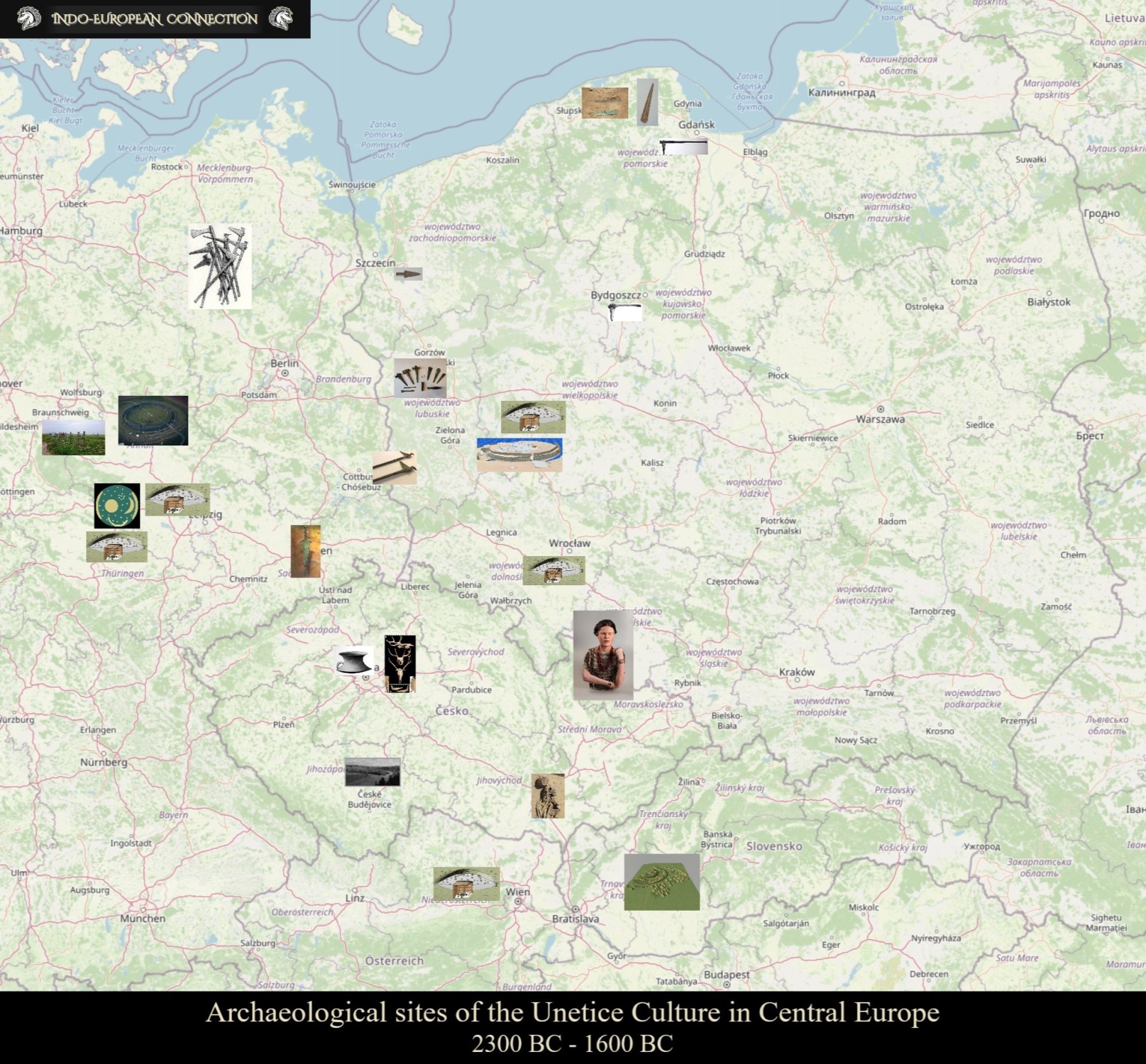
Around 2100 BC - 2000 BC a continuous rise in the flow of metals to Southern Scandinavia begins. First to arrive via the central German Únětician hubs was high-impurity metal from the Austrian Inn Valley and Slovakia. This was complemented by high-tin British metal, enabling early local production of tin bronzes[60]. Increased metal use locally fuelled the leadership competitions visible in the metal-led material culture. The Únětice downfall around 1600 BC resulted for a short period in a raw materials shortage, visible in the reuse of existing stocks, but stimulated direct Nordic access to the Carpathian basin. This new access expedited innovations in metalwork with reliance on chalcopyrite from Slovakia, as well as opening new sources in the Eastern Alps, along an Eastern route that also conveyed Baltic amber as far as the Aegean. British metal plays a central role during this period. Finally from around 1500 BC, when British copper imports ceased, the predominance of novel Northern Italian copper coincides with the full establishment of the Nordic Bronze Age and highlights a Western route, connecting the Nordic Bronze Age with Southern German Tumulus Culture and the first transalpine amber traffic[61].
During the period of its full development, the Madarovska/Mad'arovce Culture ("maďarovská kultúra" in Slovakian) interacted in the Western direction and also to some extent in the Northern direction. As a result of these influences, and probably also due to the displacement of the people of the Madarovska/Madarovce Culture to the areas previously occupied by the people of the Unetice Culture, a new cultural unit, the Věteřov Culture (1800 BC - 1500 BC) was created in Southern and Central Moravia, as well as in the adjacent part of Lower Austria[62]. The influence of the Madarovska Culture in the Northern direction led to the formation of the Nowa Cerekwia Group in Upper Silesia, especially on the Glubczyce Plateau. The period of this expansion is described by some researchers as "Bronze A3". The Madarovska Culture began to disappear during the Bronze B1 period (1700 BC - 1500 BC), persisting longest in the North-Western Hungary.
DNA
Those are the reults from some of the Czech samples from the times of the Unetice Culture: Moravská Nová Ves (I4141) was deterimned to belong to Y-DNA G2a and mtDNA U4c1a; another sample from Prague 5, Jinonice, Zahradnictví (I7197) to Y-DNA I2a and mtDNA X2b6; Prague 5, Jinonice, Zahradnictví (I7202) to Y-DNA R1b-P312 (from R1b-L151) and mtDNA U5a1a2b; Prague 5, Jinonice, Zahradnictví (I7196) to Y-DNA R1b-S1894 and mtDNA K1a+195. In general there are many R1b samples in Czech Republic already from the times of the Bell Beaker Culture, meaning that R1b appeared there with spread of the Corded Ware Culture around 3000 BC.
Early Corded Ware males from Bohemia, Czechia with R1b-L51/R1b-U106 also display a lot of Steppe (Yamna) related ancestry. Y-DNA samples from around 2250 BC from Prague are following: R1b-P312, R1b-L151, R1b-P312 (I4890). 2250 BCmale from Lochenice (I5666) carried the R1b-BY3508 haplogroup (from R1b-U152/R1b-S28), 2150 BC male from Velke Pilepy (I6480) carried the R1b-L2 haplogroup, .
2175 BC man from Jordanów, Poland (I6580) carried the R1b-L2 haplogroup. Later R1b-L2 carriers were largely contemporary with R1b-U152 carriers leading to R1b-L2 also having multiple large and diverse branches, of which some are respectively linked to Italics (Origins of Latin) and the Alpine Celts (P-Celtic Gauls) .
The Y-DNA results from 2300 BC - 2150 BC Bell Beaker Culture/Straubing Culture cemetery in Irlbach, Germany (very close to Unetice Culture in Bohemia) were following: R1b-P297 (parent of R1b-M269) x2, R1b-L2 (from R1b-U152) x3, R1b-M269 x3. From Alburg, Germany (near Irlbach): R1b1a, R1b-L151, R1b-L2 (from R1b-U152) x2, R1b-M269, R1b-P312[63]. Those are the Y-DNA haplogroups nowadays common in Northern Italy, Switzerland and Eastern France.
What is even more interesting is that Unetice samples already carry the Y-DNA R1a haplogroup, for example R1a-M198 in I5042 - Moravská Nová Ves and R1a-M417 in I5037 - Moravská Nová Ves. Those are very old haplogroups and certainly would evolve already into deeper clades around 2000 BC, that is why they should be checked again for R1a-M458 or R1a-Z280 deeper clades.
 According to a study from 2020 by Papac et al. the first R1a-M417 (R1a-Z645) appeared in Bohemia, Czechia around the year 2750 BC and in the next 500 years became widely spread through a selective clan mating[64]. A male who carried the R1a-M417 haplogroup in Bohemia in his autosomal and Y chromosome DNA resembles males from the Bronze Age Latvia and males from the later Unetice Culture. Another haplogroup common in Bohemia around the same time was the R1b-L51 haplogroup ancestral to Western Europeans and Italians[64].
According to a study from 2020 by Papac et al. the first R1a-M417 (R1a-Z645) appeared in Bohemia, Czechia around the year 2750 BC and in the next 500 years became widely spread through a selective clan mating[64]. A male who carried the R1a-M417 haplogroup in Bohemia in his autosomal and Y chromosome DNA resembles males from the Bronze Age Latvia and males from the later Unetice Culture. Another haplogroup common in Bohemia around the same time was the R1b-L51 haplogroup ancestral to Western Europeans and Italians[64].
In the same paper there is detected an important resurgence of EHG ancestry in the Unetice Culture after 2200 BC coming from the East from the Chłopice-Veselé/Mierzanowice Culture[65]. This also corresponds to the time of appearance of DOM2 type horse in Western Europe from the area of modern Northern Moldova (Gordinesti II) and Western Ukraine[66][67].
Polish Copper Age and Bronze Age samples starting around 3000 BC carry Indo-European Y-DNA lineages R1. A man from Obłaczkowo in Greater Poland dated to 2865 BC - 2578 BC already carried R1a-Z280 (descended from R1a-Z282 and an earlier R1a-Z283). Two men from Rogalin near Hrubieszów dated to 1900 BC - 1615 BC carried R1a1a1 (R1a-M417+). A man from Gustorzyn in Kuyavia, Poland dated to 1953 BC - 1880 BC carried R1a1a1b1a2c-S24902 (subclade of R1a-Z280). Today up to 1% of Poles belong to the same lineage of R1a1a1b1a2c-S24902.
Y-DNA haplogroup R1a-V2670 (R1a-CTS3402 from R1a-CTS1211/R1a-M558 and R1a-Z280) was already found in S9 burial dated to 2560 BC - 2290 BC from Somogyvár-Vinkovci Culture in West Hungary[68]. He carried the mtDNA haplogroup K1a3a. Other burials dated to 2200 BC - 1770 BC from the Kisapostag carried the Y-DNA I2a-L1229. Two male burials from around 1800 BC from Transdanubian Encrusted Pottery Culture carried the R1b-Z2103 haplogroup[68].
This 1800 BC burial could indicate the earliest appearance of this important R1b-Z2013 haplogroup common in the Yamna Culture, Afanasievo Culture, modern Albania, Armenia and Hittite Turkey. RISE555 is an even earlier (2800 BC - 2500 BC) sample of R1b-Z2013 (actually its child R1b-Z2016) from Volgograd, Russia[69]. Notice that modern Northern Turkey also has 5% of R1a-CTS1211/R1a-M558 next to R1b-Z2103. This could explain why Luwian was a Satem language (R1a-M558) and Hittite was a Centum language (R1b-Z2013). The first written record of Hittite, the Anitta Text comes from around 1720 BC, 80 years after the Transdanubian burial. The earliest settlement in Hittite Turkey with the remains of European DOM2 horse type in Acemhöyük was radiocarbon dated to 1793 BC. According to a study from 2020, new types of horses appeared in Anatolia after 2000 BC[70].
Three skeletons from Eulau, Germany from around 2600 BC were determined to belong to Y-DNA haplogroup R1a[71].
According to a study from 2016 the large variability and repeated diminution in size of horses in the Unetice Culture (2200 BC - 1700 BC) could indicate advanced domestication or multiple origins of the populations (or both). The persistence of wild horses in the Early Bronze Age can not be proved osteometrically, but the presence of domesticated horses is considered certain[72]. A genetic study from 2020 on DOM2 type horses confirms the previous conclusion[73].
According to a PNAS study from 2017 the male mobility was minor in Bavarian Lech Valley from 2500 BC until 1600 BC as tested on 84 individuals. However, they proved that women in that area came mostly from Bohemia, Birtain and Eastern Germany[74][75]. It is also a proof for the patriarchal society structure in Europe during the Bronze Age. It was a woman who had to change her home and start living with her new husband. This tradition was well preserved in all Slavic countries until modern times.
According to the archaeological analysis and radiocarbon dating, the population of Šoporňa, Slovakia lived in the Early Bronze Age (2022 BC - 1897 BC). Genetic analysis has revealed six types of mitochondrial (mtDNA) haplogroups actually belonging to the two basic cladogenetic groups. One group includes N1a (N1a1b2) and I (I1a1a) and the second one includes T group. Haplogroup I was one of the significant components both in the late Neolithic period and the Early Bronze Age, while haplogroup T2 can also be found in the Únětice Culture populations[76].
Autosomal DNA of a woman buried between 1880 BC - 1750 BC in Mikulovice, Czech Republic indicated that she had brown eyes, brown hair, strong chin and light skin[77]. Palaeopathological analysis of 37 skeletons from same site showed that some of them had tuberculosis, dental hypoplasia, Pott's disease and one had osteoma (bone tumor)[78].
In one article about Czech ancestors they state: "Within the country there are also noticeable regional divides in ancestry. Czechs from South-West Bohemia are closer to the Bavarian population, whereas their compatriots from Eastern Bohemia are closer to Poles, Slovaks and Moravians." and "According to the archaeogenetics expert, this closeness to Western European populations is the result of the spread of peoples from the so-called Bell Beaker culture into Central Europe during the Neolithic period roughly four thousand years ago.", so they provide genetic evidence against the Slavic invasion in the 6th century AD but still call this population pre-Slav: "The Czech population is predominantly descended from the prehistoric population, before the arrival of the Slavs. We are biologically a majority pre-Slav population."[79].
By making such illogical statement they literally state that the spread of the Slavic languages occured only by culture, not by genes (not by physical people, who carried their culture with them). It means that there would not be any Slav specific words visible in Western European languages such as Latin or Celtic P/Q if this would be true and the results in the "Origins of Latin" section prove the opposite (there still could be cognates but in amounts like Tocharian A/B or Hittite, which are genetically not related to Western European populations, so surely they reults would be below 10%, not 24%). With 100% certainty it can be stated that the evolution of the Slavic languages took place in the territory of the Corded Ware, Mierzanowice, Trzciniec and later Lusatian cultures, and the population of the Unetice Culture was already genetically and culturally (linguistically) closely related to those people/cultures (even to the Sintashta Culture).
The Sorbs (Eastern Germany) showed greatest genetic similarity to Poles, followed by Czechs, Slovaks and two German populations. The Sorbs were most different to Serbia and Montenegro, likely reflecting the considerable geographical distance between the two populations. Same results were received when comparing the Y-DNA haplogroups[80].
If Slavs spread evenly in the 6th century AD why then Sorbs are so different when compared to Serbians, if true genetic replacement happened and all those people would come from one unified Slavic population (also speaking one Proto-Slavic language), then the genetic similarity would be the highest no matter what Slavic population would be compared. Modern Poles would not show the highest genetic similarity to Tollense Valley warriors (1250 BC) if this would be the case[81]. There would be no difference in morphology between skeletons from different Slavic and European populations (there is[82]).
The homogenous genetic strata of the West Slavic populations and the Slovenian population suggest the existence of a common ancestral population in Central European region. The R1a-Z92 branch of R1a-Z280, which is significant among East Slavs is recorded as completely absent among Slovenes. In 2016 study, including 100 sampled Slovenians, 27.1% belong to R1b, of which 11.03% of R1b belongs to the R1b-P312 branch, 6% to the Eastern branch and 4% to R1b-U106. In the 2018 autosomal analysis of Slovenian population, the Slovenes clustered with Hungarians and were close to Czechs[83].
When it comes to Scandinavia and its genetic relation to the Unetice Culture, besides the proven bronze metal imports, there is not much evidence for earliest R1b samples in Denmark, Norway or Sweden yet. Still, some of the Corded Ware Culture (Battle Axe Culture) individuals from Scandinavia already show the Steppe (Yamna) related ancestry in their autosomal DNA[84]. That is why the spread of the Indo-European culture and language to Scandinavia does not have to be related to the Unetice Culture, altough 19% of all cognates in Latin are related to Germanic and could point to such origin.
Eupedia user Maciamo made an analysis of modern R1b subclades in Scandinavia and the results from 100 samples were following: 3.6% of R1b-L23 (too ancient, Yamna related); 38.7% of R1b-U106/R1b-S21 (Bell Beaker and CWC related); 2.7% of R1b-P310 (maybe Unetice Culture related); 11.7% of R1b-312 (nowadays common in France, Spain and British Isles); 5.4% of R1b-L238 (Scandinavian branch closest to the Unetice); 3.6% of R1b-DF27 (Basque); 25.2% of R1b-L21 (Irish and P Celtic); 9% of R1b-U152/R1b-S28 (purely Northern Italy; also probably Unetice related);[85]. In total 17% of all Scandinavian R1b could possibly come from the Unetice Culture but still 100 samples are not enough and it is not known when exactly those subclades appeared in Scandinavia.
Haplogroup R1b is present at a frequency of 36.1% among Danes [Sanchez et al. 2004], 31.3% among Norwegians [Dupuy et al. 2006] and 23.6% among Swedes [Karlsson et al. 2006]. Haplogroup R1a is present at a frequency of 26.3% among Norwegians [Dupuy et al. 2006], 24.4% among Swedes [Lappalainen et al. 2008], and 16.5% among Danes [Sanchez et al. 2004]. Most of the R1a in Scandinavia is of the R1a-Z284 branch, descended from the Battle Axe Culture (Corded Ware Culture).
According to Eurogenes Blog, the earliest ancient Scandinavian individual belonging to R1b-U106 is dated to 2275 BC - 2032 BC (RISE98 from Lilla Beddinge, Sweden). However, he wasn't buried in any way that would suggest he was an individual of high social status. In fact, he was found in a mass grave, along with two other adults and two infants, possibly representing a human sacrifice. The only artefact in the grave was a bone needle. Other Early Bronze Age Scandinavian R1b-M269 samples came from Aalborg, Denmark (RISE47) and from Trundholm, Denmark (RISE276)[86].
Article created between the 15th of April 2022 and 5th of August 2022. First published on the 6th of August 2022.

